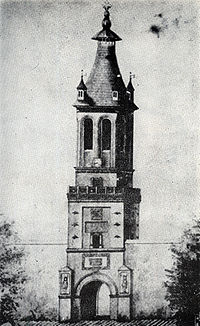
Turnul Coltei
Encyclopedia

Tower
A tower is a tall structure, usually taller than it is wide, often by a significant margin. Towers are distinguished from masts by their lack of guy-wires....
located in Bucharest
Bucharest
Bucharest is the capital municipality, cultural, industrial, and financial centre of Romania. It is the largest city in Romania, located in the southeast of the country, at , and lies on the banks of the Dâmbovița River....
, Wallachia
Wallachia
Wallachia or Walachia is a historical and geographical region of Romania. It is situated north of the Danube and south of the Southern Carpathians...
, now in Romania
Romania
Romania is a country located at the crossroads of Central and Southeastern Europe, on the Lower Danube, within and outside the Carpathian arch, bordering on the Black Sea...
. Having a height of 50 metres, it was the highest building in the city for more than a century. Its initial purpose was to be used as a bell tower
Bell tower
A bell tower is a tower which contains one or more bells, or which is designed to hold bells, even if it has none. In the European tradition, such a tower most commonly serves as part of a church and contains church bells. When attached to a city hall or other civic building, especially in...
— its 1,700 kg bell, was moved to the Sinaia Monastery
Sinaia Monastery
The Sinaia Monastery, located in Sinaia, in Prahova County, Romania, was founded by Prince Mihail Cantacuzino in 1695 and named after the great Sinai Monastery on Mount Sinai. As of 2005, it is inhabited by 13 Christian Orthodox monks led by hegumen Macarie Bogus...
after the tower was demolished. Its was also meant to serve as a watch tower.
The tower was named after Vornic
Vornic
Vornic was a historical rank for an official in charge of justice and internal affairs. He was overseeing the Royal Court. It originated in the Slovak nádvorník. In the 16th century in Moldavia were two high vornics: one for "Ţara de Sus" , and other for "Ţara de Jos" ....
Colţea Doicescu. His brother, Udrea Doicesu, built a small wooden church on the plot near the tower; after he was assassinated, the church and the land next to it were inherited by Colţea, who donated them to the Orthodox Church
Romanian Orthodox Church
The Romanian Orthodox Church is an autocephalous Eastern Orthodox church. It is in full communion with other Eastern Orthodox churches, and is ranked seventh in order of precedence. The Primate of the church has the title of Patriarch...
. The Church sold the patch of land near the church to Spătar Mihai Cantacuzino, who, in 1701, used it as the location for the first hospital in Wallachia, the Colţei Hospital, and also decided to build a tower.
The tower was built between 1709 and 1714, its construction being assisted by the Swedish
Swedish Empire
The Swedish Empire refers to the Kingdom of Sweden between 1561 and 1721 . During this time, Sweden was one of the great European powers. In Swedish, the period is called Stormaktstiden, literally meaning "the Great Power Era"...
soldiers of the army of King Charles XII
Charles XII of Sweden
Charles XII also Carl of Sweden, , Latinized to Carolus Rex, Turkish: Demirbaş Şarl, also known as Charles the Habitué was the King of the Swedish Empire from 1697 to 1718...
, who had fled to Wallachia after the disastrous defeat at the Battle of Poltava
Battle of Poltava
The Battle of Poltava on 27 June 1709 was the decisive victory of Peter I of Russia over the Swedish forces under Field Marshal Carl Gustav Rehnskiöld in one of the battles of the Great Northern War. It is widely believed to have been the beginning of Sweden's decline as a Great Power; the...
. Mihai Cantacuzino kept his secret archive
Archive
An archive is a collection of historical records, or the physical place they are located. Archives contain primary source documents that have accumulated over the course of an individual or organization's lifetime, and are kept to show the function of an organization...
inside the tower.
An earthquake on October 14, 1802 destroyed its top part, including its clock
Clock tower
A clock tower is a tower specifically built with one or more clock faces. Clock towers can be either freestanding or part of a church or municipal building such as a town hall. Some clock towers are not true clock towers having had their clock faces added to an already existing building...
; in 1888, it was demolished completely. Two years later, in 1890, another structure was built as a watch tower, Foişorul de Foc
Foisorul de Foc
Foişorul de Foc is a 42-metre high building in Bucharest, Romania, between Obor, Calea Moşilor and Nerva-Traian. It was used in the past as an observation tower by the firemen....
.

